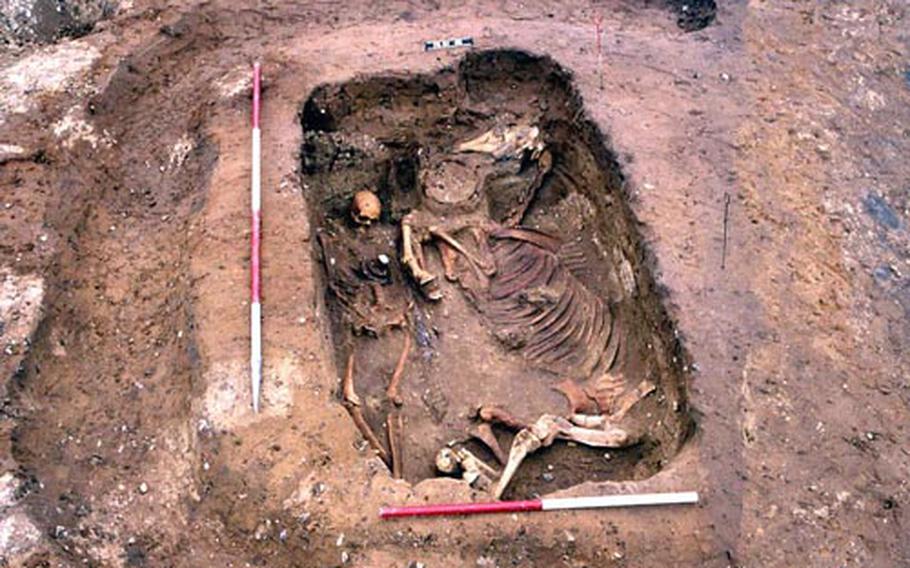
The remains of an ancient Anglo-Saxon warrior and his horse were unearthed at RAF Lakenheath in 1997. The base must work with British archaeology officials for every base construction because of the area’s dense concentration of buried artifacts. (Photo courtesy of Suffolk County Council Archeological Service)
RAF LAKENHEATH
Relics of this base’s ancient inhabitants recently were unearthed during a routine construction project.
Before the Air Force set up shop at Lakenheath more than 60 years ago, it was home to the Anglo-Saxons — ancient peoples who inhabited the south and east of the country from the early fifth century through the Norman conquest of 1066.
Toiling alongside a construction crew that rebuilt the traffic circle on the northside of the base in August, a team of British archaeologists dug up three Anglo-Saxon graves dating to between 450 and 650.
The graves held the remains of two men with spearheads and a woman buried with jewelry, broaches and wrist clasps. They are the latest finds in a decadelong project that has positioned the ground below the base as one of the region’s largest ancient burial grounds, said Jo Caruth, senior project officer for the Suffolk County Council Archaeological Service.
While the contents of the graves are significant, the real boon was that archaeologists can now more clearly define the perimeter of the entire burial site at Lakenheath, Caruth said.
"It’s major in that sense because [the grave] gives us more information about the Anglo-Saxons," she said. "Being able to look at the grave site as a whole will give us tremendous insight into how they lived their lives."
The most important find at Lakenheath came in 1997 when an Anglo-Saxon warrior chief, buried with his horse, was uncovered near the burial site, she said.
Other ancient artifacts have been unearthed over the years at Lakenheath and RAF Mildenhall — hot spots for archaeological digs thanks to the chalky soil that helps preserve artifacts by preventing acid erosion. Suffolk is also home to several other large Anglo-Saxon settlements, including West Stow and Lackland Lakes, just a few miles from the two bases, Caruth said.
Previous searches have revealed graves, bones and implements from 10,000 years ago, the Neolithic period, the Bronze and Iron ages, and from Roman and Saxham settlements and burials, according to British and American officials.
Caruth’s office works with base officials — including the Ministry of Defence and British Defence Estates personnel — to ensure potential archaeological finds are preserved when construction takes place. Many times, Caruth said, the archaeologists can determine where artifacts should be buried.
This helps the coordination process with base officials, but "we look at everything. If somebody wants to sink a fence post, we’ve got to look at the archaeology," said Richard Southgate, environmental program manager at Lakenheath.
Archaeologists believe a batch of medieval ruins could be located underneath the control tower on the flight line and that a 3,000-year-old burial is likely sitting below the ground near a planned housing area. Both of those archaeological projects are likely to get under way in the next year, Southgate said.
"It’s interesting because it shows there’s been a continuity of human occupation on the site," he said.